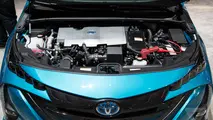GE’s fuel-efficient marine technology powers the world’s largest container vessels by Maersk

GE’s Marine Solutions recently delivered its power take off/power take in (PTO/PTI) solution along with its Power Management System digital software solution onboard four of the world’s largest container vessels owned by Maersk Line—Madrid Maersk, Munich Maersk, Moscow Maersk and Milan Maersk.
Madrid Maersk is the first container vessel delivered from Daewoo Shipbuilding & Marine Engineering —back in April—and Munich Maersk and Moscow Maersk have both completed successful sea trials. Milan Maersk will soon be in service. These vessels are among the 11 Maersk second-generation ultra large container vessels called the EEE Mark II. Having a capacity of 20,568 twenty-foot equivalent units (TEUs) each, these vessels are the world’s largest by TEU carrying capacity.
“The future of shipping requires more-efficient vessels with cleaner technologies that meet stringent environment regulations. Maersk’s EEE Mark II series of container vessels are among the world’s largest, and we will use them to move the greatest volume of goods in the most energy-efficient manner with the smallest emissions footprint possible in the industry. The secret lies behind the technology we use to power the vessels and the way we utilize the energy,” said Steffen Hartvig Nielsen, senior project manager, Maersk Line. “GE’s propulsion and software system creates energy savings and is helping us achieve our sustainability strategy, which aims to reduce carbon emissions per container vessel by 10 percent.”
The innovative PTO/PTI solution can result in significant fuel savings and operational flexibility. The solution consists of two GE motor-generator sets that sit on the two propeller shafts while connecting to the GE MV7000 drives. During the PTI mode, the motor-generator sets play the role of an electric propulsion system that provides additional motor power—beyond that of the main diesel engines—to propel the vessel. When the need for propulsion power is reduced, the motor-generator sets switch to the PTO mode, harnessing the mechanical energy from the shaft and converting the otherwise wasted energy into electricity to generate power for electrical equipment onboard the vessel.
“Typically, one diesel engine can consume as much as eight tons of fuel per hour. Saving even just 1 percent of fuel will generate significant savings for the customer,” said Bruno Daubas, project director, GE’s Marine Solutions. The two modes are completely reversed processes and, therefore, require robust drives and software to ensure a smooth switch between two modes and to react in a highly responsive manner. During the sea trial of Madrid Maersk, when the modes switched, all equipment kept running without the slightest interruption—without even a flicker of a lightbulb.”
The motor-generator sets use induction motors instead of their synchronous peers. The induction motors enjoy a simpler design. By removing transformers, the sets are more reliable and require less maintenance. Combined with the solution’s fuel-saving feature, this further reduces opex for customers.
Moreover, GE’s Marine Solutions also provided its digital software solution, Power Management System, to fully automate the operation. The software is connected to all generators onboard the vessels. Based on the required sailing speed, the system will optimize fuel usage and, therefore, generate opex savings and optimized vessel performance for operators.
“In container shipping, falling rates have been offset to a degree by low fuel prices. Unbalanced supply and demand, however, have put increasing pressure on vessel operators to continue to cut costs. Environmental regulations have also raised clear challenges,” said Azeez Mohammed, president and CEO, GE’s Power Conversion business. “GE’s solutions will help Maersk’s container vessels achieve improved fuel efficiency and performance, enabling them to move more goods worldwide with a reduced environmental impact on the sea.”



